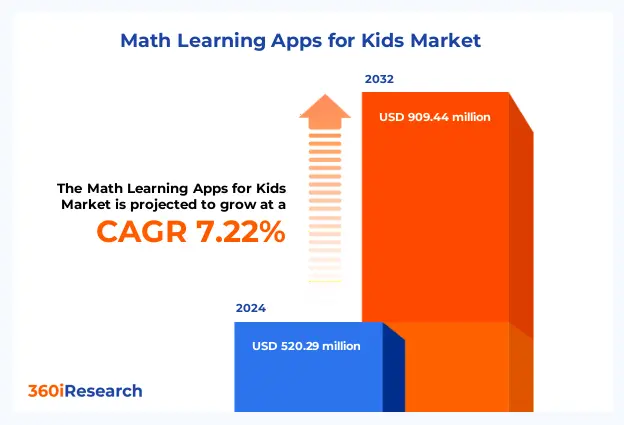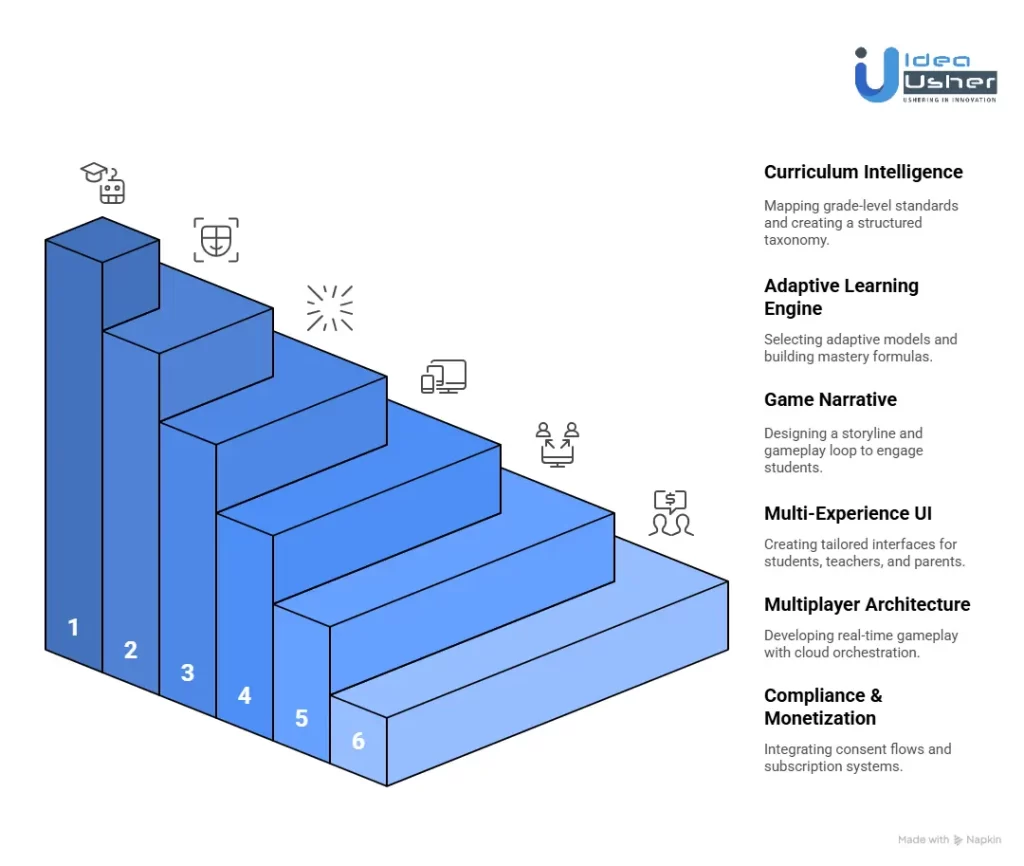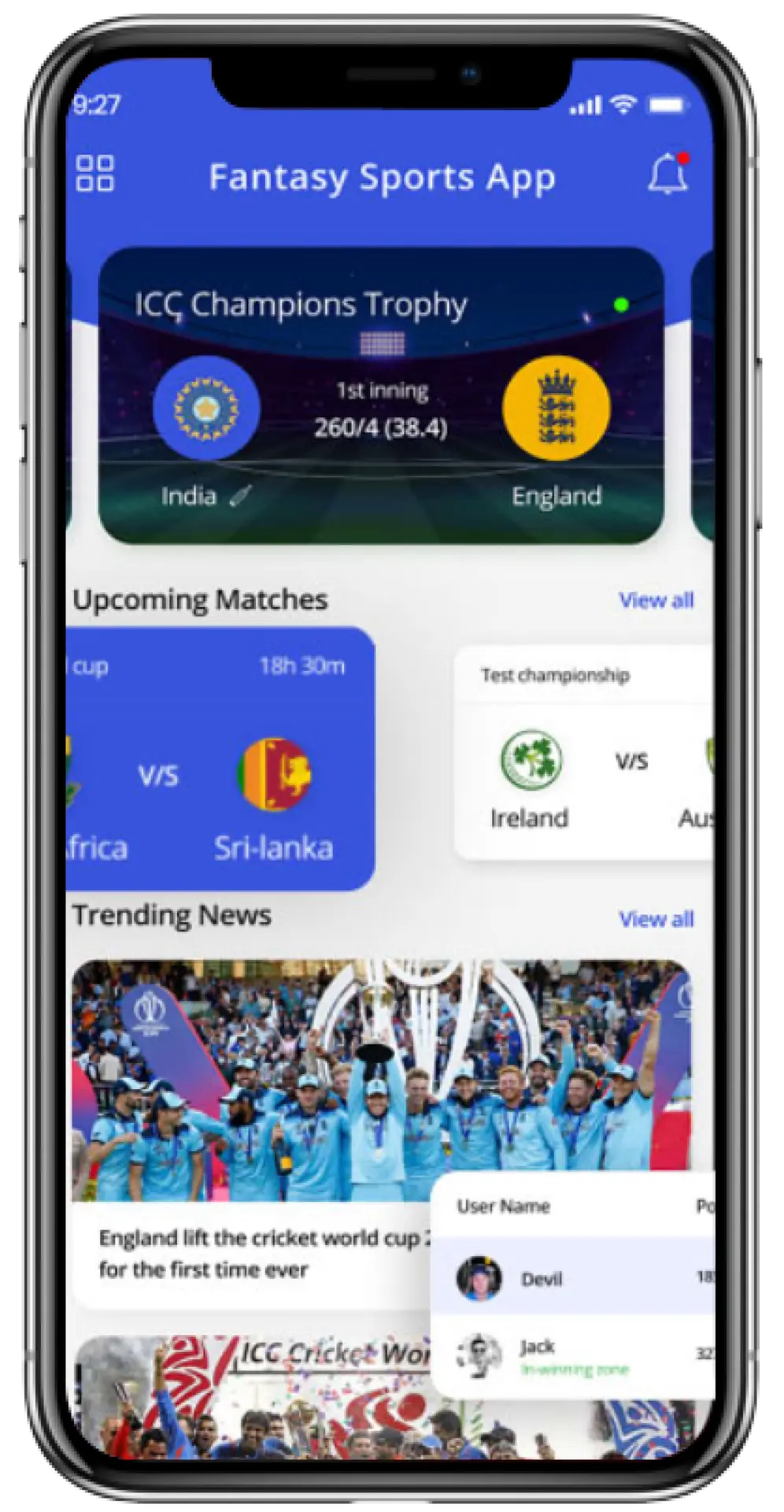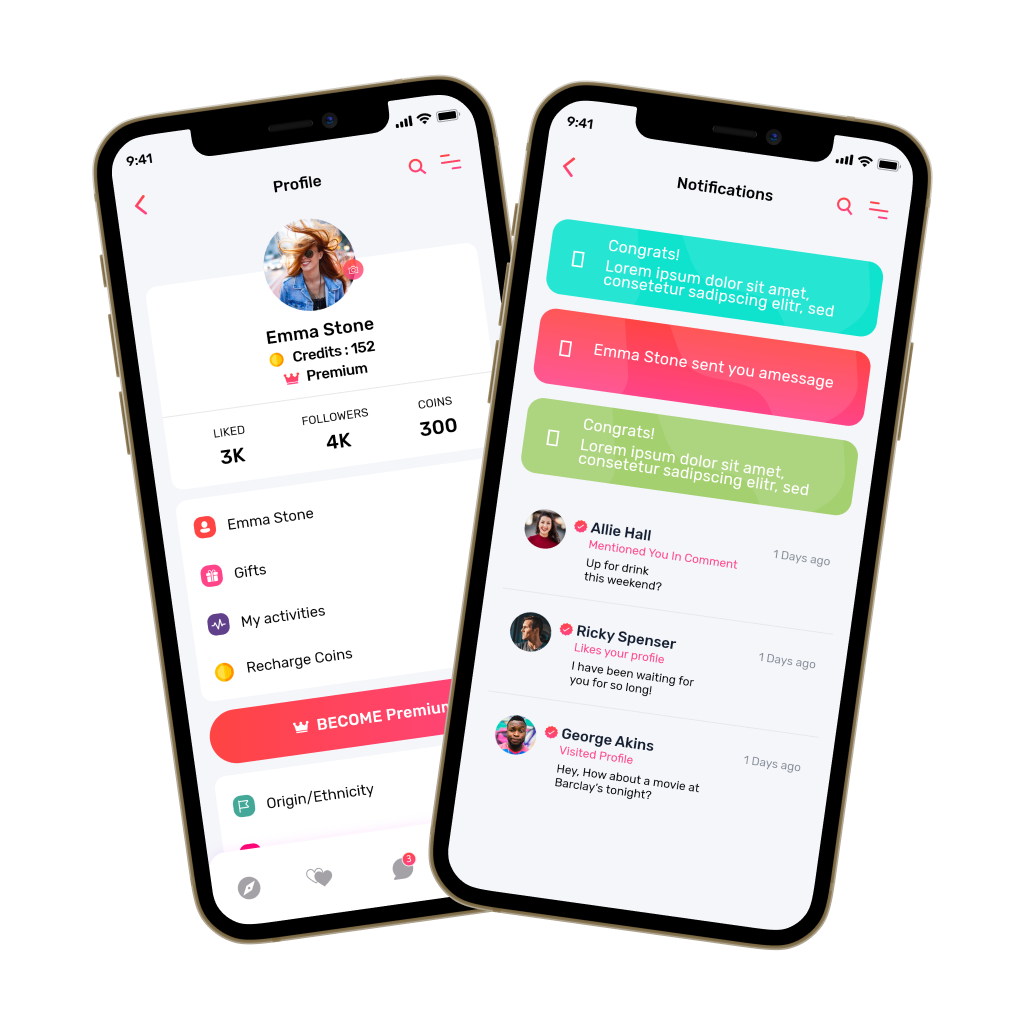Somewhere between homework frustration and shifting classroom expectations, learning math has become a real challenge for many kids. Parents and teachers often notice how quickly attention fades when lessons feel repetitive. Math learning apps like Prodigy can genuinely change that by turning concepts into interactive moments with features like real-time difficulty adjustment and in-game rewards that encourage steady progress.
These apps can guide students through personalized quests that match their skill level and keep them curious. Visual problem solving and story-driven challenges also help students stay focused without feeling pressured.
We’ve spent years working in the EdTech space, building a wide range of learning solutions powered by adaptive learning architecture and gamified learning intelligence. With that hands-on experience, we’re writing this blog to discuss the steps to develop a math learning app like Prodigy. Let’s start!
Key Market Takeaways for Math Learning Apps
According to 360iResearch, the market for math learning apps is gaining momentum, rising from USD 520.29 million in 2024 to a projected USD 555.41 million in 2025. With a steady 7.22% CAGR expected to push the market to USD 909.44 million by 2032, the growth reflects a long-term shift toward digital, game-based, and adaptive learning tools used at home and in classrooms.

Source: 360iResearch
Families are turning to these apps because they offer personalized and engaging ways for kids to build math confidence. Prodigy Math Game blends curriculum-aligned practice with a fantasy-style adventure that encourages sustained participation, while Khan Academy Kids offers thousands of free lessons designed to support early learners from diverse backgrounds.
Partnerships are increasingly shaping the future of the sector. A notable example is the 2025 collaboration between Khan Academy and Microsoft, which combines Khan Academy’s free educational tools with Microsoft’s Azure AI capabilities. The goal is to broaden access to high-quality math support and accelerate the development of scalable, affordable AI tutoring across education platforms.

What Is the Prodigy App?
Prodigy is a free, web-based learning platform that turns math practice into an adventure. It uses a fantasy role-playing game style where students create their own wizard characters and explore a colorful virtual world. As they move through quests, battles, and challenges, they answer curriculum-aligned math questions that match their grade level and adapt to their progress.
The app is built for younger learners and is widely used in classrooms and at home. Teachers and parents can track how students are doing through built-in dashboards. Prodigy also offers a companion English version that focuses on reading and language skills, which expands the program beyond math.
Here are some its standout features,
Character Creation and Growth
Students design their own wizard characters and equip them with items they earn in the game. As they play, characters gain levels, unlock new abilities, and grow stronger. This gives students a sense of ownership and progress.
Explorable Zones on Prodigy Island
The game world is divided into distinct zones, each with its own storylines, characters, and quests. Students travel through these areas as they complete math challenges connected to the adventure.
Story-Driven Quests and Mini-Games
Quests move the story forward and often lead into battles or puzzles powered by math questions. Mini-games such as Dyno Dig offer breaks from battles while still reinforcing key skills.
Collectible Rewards
Players gather items such as outfits, wands, gems, and accessories that improve their character’s stats or simply add personality. These rewards help keep students motivated and curious.
Pet Collection and Battles
Students can collect and train pets, each with its own strengths. Pets form a team that supports the player in battles that require answering math problems in order to attack or defend.
Mythical Epics (Premium Feature)
Students with memberships can access rare and powerful pets called Epics. These pets come with special questlines and unique abilities that add extra depth to the game.
Daily Bounty Board
The Bounty Board gives students new challenges each day. These challenges offer rewards and encourage consistent practice.
Safe Social Play
Players can celebrate achievements, compare progress, and challenge friends in safe and moderated Player vs Player battles. The game does not include open chatting or unsafe communication features.
Parent and Teacher Dashboards
Adults can view clear insights into what students are practicing, where they are improving, and where they may need extra help. This makes it easier to guide learning at home or in the classroom.
How Does the Prodigy App Work?
Prodigy may look like a fun fantasy RPG at first glance, but underneath the colorful world and monster battles is a sophisticated learning system. The game blends entertainment with education in a way that keeps students practicing math without it feeling like homework. Here is a clear look at how it all works behind the scenes.
Prodigy’s design revolves around a continuous learning loop that connects three groups: students, teachers, and parents. Each group plays a role in making the experience both fun and academically meaningful.

Step 1: The Student Enters the Game World
Creating a Wizard
Every new player begins by creating a custom wizard character. They choose a name, appearance, and starter gear. This simple step helps students feel personally invested in the adventure.
The Invisible Placement Test
Once the student starts completing early quests and battles, the game quietly evaluates their skills. This acts as a built-in placement test. It identifies strengths, weaknesses, and gaps in understanding, then builds a personalized learning path from that information. Students do not realize they are being assessed, which removes pressure and keeps the experience natural.
Step 2: The Core Gameplay Loop
This is where Prodigy shines. The entire game runs on a simple but effective cycle that links gameplay to math practice.
- Explore and Accept Quests: The student travels through different zones, speaks with characters, and completes story-driven tasks.
- Encounter a Monster: Battles appear naturally during exploration. Each monster encounter is a chance to practice math.
Cast Spells by Solving Math Problems
To attack, defend, or use abilities, the player must answer a math question. The better the answer, the stronger the spell.
- If the answer is correct, the spell succeeds and deals full damage.
- If the answer is incorrect, the spell weakens or fails. The game often offers a hint or explanation to turn the mistake into a learning.
This loop is effective because the desire to win battles encourages consistent practice without the need for external rewards or pressure.
Step 3: The Adaptive Learning Engine
As the student plays, Prodigy constantly analyzes their performance.
Real-Time Assessment
Every answer tells the system something. It considers accuracy, response time, and error patterns.
Instant Difficulty Adjustment
If a student shows strong understanding, the app gradually increases difficulty. If they struggle, the system offers extra practice or returns to foundational skills. The goal is to keep students challenged without overwhelming them.
Curriculum Alignment
All math questions come from a large database aligned with official curricula such as Common Core and TEKS. This ensures that what students practice in-game directly supports what they learn in school.
Step 4: The Teacher Dashboard
Teachers get a free, powerful dashboard that helps them connect gameplay to classroom goals.
Assign Specific Skills
Teachers can choose the exact math topics they want students to practice. When students log in, battles and questions reflect those assigned skills.
Track Class and Student Progress
Reports show which concepts are mastered, which ones need more attention, and which students may require extra support. This real-time data makes it easier for teachers to guide instruction.
Step 5: The Parent Portal
Parents also play an important role in the learning loop.
Monitor Progress: Parents can see what skills their child is working on and how they are improving.
Encourage Engagement: Prodigy offers optional memberships that unlock cosmetic upgrades such as pets, outfits, and special areas. These items do not change the educational content but provide extra motivation for students who enjoy collecting and customizing.
What is the Business Model of the Prodigy App?
Prodigy, created by Prodigy Education, operates using a freemium model that makes its educational math game available to as many students as possible while generating revenue through optional upgrades. The company focuses on keeping its core learning experience free, which has helped it reach a very large global user base.
A Free Core Experience
The main Prodigy Math Game is free for students, parents, and teachers. Anyone can create an account and access the full educational content without paying, which makes the platform easy for schools and families to adopt.
Freemium Structure
Revenue comes mainly from optional paid features. Prodigy offers premium memberships designed to enhance the game without locking away academic content.
Membership pricing typically begins around $4.99 per month.
Paid membership includes perks such as:
- Exclusive pets, outfits, and items
- Special zones and cosmetics
- Personalized goal tracking
- Access to video lessons and accelerated rewards
- More customization for player characters
These features are designed to motivate students rather than restrict learning for free users.
In-App Purchases
Players can also purchase virtual currency that lets them buy cosmetic items and upgrades inside the game. This creates an additional revenue stream while keeping all educational elements fully accessible without payment.
School and District Licenses
Beyond individual subscriptions, Prodigy sells discounted school and district licenses. These packages unlock premium features and expanded teacher tools for entire classrooms or school systems.
Partnerships and Limited Advertising
Prodigy occasionally includes small-scale ads or sponsored content. These are limited so the platform remains primarily focused on education rather than marketing.
Financial Performance
- Prodigy Education generates an estimated $75.1 million in annual revenue.
- The platform reported more than 100 million registered users worldwide as of early 2021.
- The company employs over 400 staff members, with an estimated revenue of $175,000 per employee.
- Its freemium model and strong user adoption have supported steady financial growth and long-term sustainability.
Funding and Investment History
Prodigy Education has raised $125 million across two funding rounds.
Series B: January 2021
- Amount raised: $125 million CAD (approximately the same in USD)
- Led by: TPG Growth and the Canadian Business Growth Fund
- This round was one of the largest EdTech funding rounds in North America at the time.
- TPG Growth, which manages around $85 billion in assets, joined Prodigy’s board as part of the investment.
Use of Funds
The capital has been used to improve the Prodigy Math Game, scale the platform internationally, and expand tutoring and learning-support offerings.

How to Build a Math Learning App Like Prodigy?
Building a math learning app like Prodigy will start with an adaptive engine that can accurately track learner progress in real time. Secure authentication and a scalable backend will then support reliable delivery of level-based challenges. We have developed numerous Math Learning Apps like Prodigy for our clients over the years, and here’s how we do it.

1. Curriculum Intelligence Layer
We start by mapping grade-level standards like Common Core, TEKS, CBSE, or GCSE. Our team creates a structured taxonomy of domains, clusters, skills, and question types. Each skill includes difficulty rules, mastery targets, hint logic, and scoring so the system understands what the learner is ready for.
2. Adaptive Learning Engine
We select the right adaptive models, such as BKT, IRT, or Reinforcement Learning. Using these, we build mastery formulas that track probability, confidence, and learning gaps. The engine’s routing logic then delivers the next best question for each student in real time.
3. Game Narrative + Mechanic Loop
We design a storyline and gameplay loop where math performance powers in-game actions like spells, shields, or pet leveling. Our reward economy motivates frequent practice through XP, items, and challenges. Avatars, missions, and collectibles keep students emotionally invested.
4. Build Multi-Experience UI
Students receive an interactive game interface built for engagement. Teachers get tools for assignments, analytics, and classroom control. Parents access a simple dashboard for insights and subscription management. Each interface is tailored to its user’s needs.
5. Multiplayer Game Architecture
We develop real-time gameplay using Unity or WebGL to support cross-device battles and challenges. Our team optimizes latency and synchronization for smooth experiences. Cloud orchestration ensures the system handles large numbers of simultaneous players.
6. EdTech Compliance & Monetization
We integrate consent flows that meet education privacy standards. Subscription systems are built using Stripe, PayPal, and in-app purchase tools. Upsell prompts are designed to support learning goals without interrupting gameplay.
Why 90% Studies Confirm Math Learning Apps Help Young Children?
More than 90% of studies showed some benefit for young children’s math learning via apps because well-designed apps adapt to each child’s skill level in real time. They turn practice into play, which keeps kids engaged and reduces math anxiety. The combination of instant feedback, visual learning, and consistent short sessions makes early math skills easier to grasp and remember.
1. Personalized and Adaptive Learning
High-quality math apps adjust difficulty in real time based on each child’s performance.
Why it works:
It finds the learning “sweet spot.” Apps constantly aim to keep a child within their Zone of Proximal Development, the space where tasks are challenging enough to be interesting but not so difficult that they cause frustration.
It fills knowledge gaps quickly. If a child struggles with a specific concept such as regrouping during subtraction, the adaptive system identifies it and provides more targeted practice. A single teacher with a classroom of twenty to thirty children cannot personalize instruction at this level for every learner.
2. Learning Through Gamification
Strong apps do not simply layer rewards on top of math problems. They weave the learning into the game’s core actions.
Why it works:
It creates intrinsic motivation. Children practice math because they want to win a game, unlock a character, or complete a challenge. The learning becomes part of the fun rather than a task they feel pressured to complete.
It turns math into something magical. In a game like Prodigy, solving math problems becomes the way to cast spells or advance through an adventure. Children concentrate on the goal, and the math practice happens naturally behind it. This reduces anxiety and builds positive emotional connections with the subject.
3. Feedback-Based Learning Loops
Apps can provide corrections and explanations the moment a child answers a question.
Why it works:
It closes the feedback loop. Children do not wait hours or days to find out whether they solved a problem correctly. Immediate feedback reinforces correct strategies and prevents the reinforcement of incorrect ones.
It encourages a growth mindset. Mistakes are treated as normal and useful. A well-designed app might say, “That was a tough one. Let’s walk through how to solve it,” then offer a similar problem for another try. This builds persistence and resilience.
4. Multisensory and Visual Learning
Apps can turn abstract ideas into interactive, visual, and auditory experiences.
Why it works:
It makes abstract concepts concrete. Fractions become colorful pieces of objects children can tap and rearrange. Place value becomes animated blocks that regroup automatically when ten ones become one ten.
It engages multiple parts of the brain. When children see, hear, and physically interact with the concept, the learning becomes richer and easier to retain. This multisensory approach is far more powerful than static worksheets.
5. Consistency, Confidence, and Skill Building
Apps promote short daily sessions and offer clear indicators of progress.
Why it works:
It builds the five-minute habit. A child is far more willing to use a fun app for a few minutes each day than sit down for a long worksheet. These small bursts of practice accumulate and build strong number sense.
It gives children visible evidence of growth. Levels, stars, streaks, and completed missions help children see their improvement. This boosts confidence and shapes a mindset that says, “I can get better at math.”
How Much Revenue Can a Math Learning App Generate?
The K–12 Ed-Tech sector has become one of the most reliable spaces for scalable digital products, especially those that blend curriculum-aligned learning with game mechanics. A math app that uses Prodigy’s playbook, which combines free core learning, high engagement, and optional paid upgrades, is in a strong position for revenue growth.
Below is a clean, grounded analysis of the market and monetization model, along with a realistic financial forecast for a hypothetical math learning platform.
Market Context and Comparable Benchmarks
Prodigy Education is a privately held company, so detailed financial data is not publicly available. However, the broader Ed-Tech ecosystem offers several useful benchmarks.
- Global Ed-Tech Market: Valued at over 125 billion dollars in 2022, with K–12 as one of the fastest-growing segments.
- Byju’s (Aakash): This company demonstrates strong parental willingness to pay for educational outcomes, even under a different business model.
- Duolingo: Duolingo proves that a freemium learning app can scale rapidly and convert a small paying segment into hundreds of millions in annual revenue.
When an educational product delivers genuine learning value and keeps kids engaged, it can reach meaningful scale and monetize effectively.
The Freemium Engine
The primary revenue driver for an app like this is the Parent Membership Subscription. The model’s genius is that the core educational content remains free for schools and teachers, driving massive user acquisition at a very low cost. Revenue is then generated from a fraction of the user base who convert to a paid plan.
Primary Revenue Streams:
- Premium Subscriptions (90-95% of Revenue): Monthly or annual fees from parents for enhanced in-game features (e.g., exclusive pets, gear, bonus areas). This is the core revenue engine.
- In-App Purchases (5-10% of Revenue): Microtransactions for one-time cosmetic items or in-game currency packs.
A Realistic Five-Year Revenue Model
Below is a conservative forecast for a hypothetical app that follows the Prodigy-style freemium model.
Key Assumptions
- Target Markets: The United States, Canada, the United Kingdom, and Australia, totaling roughly 50 million K–8 students.
- User Growth: Driven largely by teacher adoption rather than paid advertising.
- Conversion Rate: 2.5 percent, which aligns with typical freemium app performance.
- ARPPU: 60 dollars per year, accounting for discounts and multi-child households.
- Operating Margin: 30 percent after cloud costs, content development, and support.
Five-Year Revenue Projection
| Year | Users (Cumulative) | Paying Users (2.5%) | Subscription Revenue | Total Revenue incl. IAP |
| 1 | 500,000 | 12,500 | $750,000 | $825,000 |
| 2 | 2,000,000 | 50,000 | $3,000,000 | $3.3M |
| 3 | 5,000,000 | 125,000 | $7,500,000 | $8.25M |
| 4 | 10,000,000 | 250,000 | $15,000,000 | $16.5M |
| 5 | 20,000,000 | 500,000 | $30,000,000 | $33M |
Why the Model Is Sound?
Adoption Curve
The growth pattern follows a standard S-curve: gradual early traction, rapid expansion as teachers adopt the app in classrooms, and stabilizing growth by Year Five. Prodigy’s user base demonstrates that a population of 20 million students is achievable.
Conversion Rate
A 2.5 percent conversion rate is reasonable. Freemium apps often convert one to five percent of users, and educational games benefit from strong child-driven demand.
At a 5% conversion rate, Year Five revenue rises to approximately $ 66 million.
ARPPU Assumptions
Prodigy’s pricing of roughly 75 dollars per year for the annual plan supports the 60-dollar blended ARPPU. Additional paid tiers would increase ARPU over time.
Low Customer Acquisition Cost
Teacher-driven adoption means a single classroom can bring in approximately 25 students at no marketing cost, creating a highly efficient growth engine.
Risks and Operational Considerations
- Curriculum Development: Maintaining standards alignment requires continuous investment.
- Competition: Several players are targeting the same audience. Strong game design and adaptive learning are key differentiators.
- Infrastructure Costs: Supporting millions of concurrent players requires significant cloud resources.
- Compliance: COPPA, FERPA, GDPR, and regional privacy laws must be followed closely.

Common Challenges of a Math Learning App Like Prodigy
The idea behind your learning game is exciting: a world so engaging that students feel like they are adventuring, not studying. But turning that idea into a stable, scalable product comes with real technical and design hurdles.
After building platforms like this for many clients, we have seen the same issues appear again and again, and we have developed reliable ways to solve them. Here is a look at the biggest challenges and how we address them.
Challenge 1: The Engagement Paradox
Every educational game faces the same tension. If the math is too difficult, students feel stuck and lose interest. If it is too easy, they become bored. A flat, one-size-fits-all difficulty curve cannot serve the wide range of learners in a real classroom.
Our solution: A Dynamic Learning Engine.
We built a two-part system designed to keep students challenged without overwhelming them.
- Adaptive ML Core: Using TensorFlow or PyTorch, we implement knowledge-tracing models that evaluate each answer in real time. This allows the system to adjust difficulty moment by moment and keep students inside their ideal learning zone.
- Engagement Awareness: We track signals such as response time and hint requests. If the student appears confused or rushed, the game can offer supportive feedback, a small tip, or a slightly easier question to prevent frustration before it builds.
Challenge 2: The Content Bottleneck
A strong adaptive system needs a deep pool of questions across grades, skills, and difficulty levels. Creating and tagging thousands of problems manually is slow, expensive, and difficult to maintain, especially when tied to standards like Common Core or TEKS.
Our solution: Scalable Content Creation Tools.
We give your content team the tools to work quickly and efficiently.
- Modular Authoring Panels: We build admin interfaces that let creators produce question templates that automatically generate variations.
- Structured Metadata Systems: Every question is stored with linked metadata such as grade, skill, standard, and difficulty. This creates a clean content graph that the adaptive engine and teacher dashboards can query instantly.
Challenge 3: The Trust Factor
Since your users are children, your platform must follow strict laws such as COPPA. Mishandling data or missing a consent step can create legal issues and quickly damage trust with parents and schools.
Our solution: A Privacy-First Architecture.
We protect student data from the very beginning.
- Kid-Safe Authentication: Parent-managed accounts and age-verification systems ensure children sign in safely and appropriately.
- Audit-Ready Consent Tracking: Consent flows are logged securely so you remain compliant at all times.
- Data Minimization: We collect only what is essential and anonymize data whenever possible.
Challenge 4: The Synchronization Problem
Students switch devices frequently. They might play on a Chromebook at school and continue on an iPad at home. If their progress or learning state does not sync correctly, the immersion breaks, and the learning flow is interrupted.
Our solution: A Real-Time, Event-Driven Backend.
We ensure that every action is captured, synced, and stored consistently.
- Event-Based Architecture: Using Kafka or RabbitMQ, actions such as answering a question or completing a mission are published as events. Multiple services consume these events immediately and update the game state, learning records, and analytics simultaneously.
- Server-Driven State Machines: The server holds the authoritative version of the game state. No matter where the student logs in, they always see their correct and up-to-date progress.
Tech Stack to Build a Math Learning App Like Prodigy
Creating a game-based learning platform that feels as alive and engaging as Prodigy takes more than clever questions and colorful characters. Under the hood, you need a tech stack capable of handling real-time gameplay, adaptive learning, school-grade security, and reliable data pipelines. Here’s a practical look at the components that make all of that possible.

1. Game Development
This is the layer students interact with first, and it sets the tone for their entire learning experience. The engine you choose determines how smooth the gameplay feels, how good it looks, and how easily you can ship updates across devices.
Game Engines
- Unity: A go-to engine for cross-platform development. You can deploy to iOS, Android, desktop, and WebGL with one codebase. Unity’s asset store, strong 2D/3D support, and tooling ecosystem make it ideal for a fantasy RPG-style adventure.
- Unreal Engine: If you’re aiming for cinematic-quality visuals or heavier 3D interaction, Unreal is hard to beat. It provides cutting-edge rendering and physics out of the box.
- WebGL (with Phaser or similar frameworks): For schools that prefer browser-only access with no installs, a lighter WebGL-based game can be a smart choice. It trades some visual fidelity for speed, accessibility, and easy deployment.
Animation & Asset Creation
- Spine 2D: Perfect for smooth, flexible skeletal animations, great for character expressions, attack sequences, and environmental effects.
- Blender: An open-source powerhouse for 3D modeling, rigging, and animation. It’s widely used for characters, props, and world-building assets.
2. Machine Learning
To truly support learning, the app has to respond to each student’s strengths and struggles. That requires a solid ML backbone capable of modeling knowledge, predicting skill mastery, and adjusting difficulty on the fly.
Core ML Frameworks
TensorFlow / PyTorch
Industry standards for building and training deep-learning models. These tools are capable of powering Knowledge Tracing systems that gauge mastery based on response patterns, accuracy, time-to-answer, and difficulty trends.
Scikit-learn
Best for simpler models, early prototyping, clustering, and preprocessing workflows.
Reinforcement Learning Options
Ray RLlib / Stable-Baselines3
Useful if you choose to treat learning progression as a reinforcement-learning problem, finding the optimal sequence of questions that leads to lasting understanding rather than short-term wins.
3. Backend & Infrastructure
This is where the gameplay, adaptive learning models, and user data all come together. The backend has to be fast, scalable, and resilient, especially during school hours when thousands of students may log in at once.
Server-Side Frameworks
Node.js: A natural fit for real-time features thanks to its non-blocking architecture. Ideal for handling game events, matchmaking, chat, and any other live interactions.
Python (Django or Flask): Strong for core application logic, admin dashboards, and ML service integration. Using Python end-to-end for ML pipelines keeps your tooling consistent.
Cloud Providers
AWS, Google Cloud, and Azure all offer the building blocks you’ll need:
- Compute: EC2, Google Compute Engine
- Managed Game Servers: AWS GameLift for handling multiplayer sessions
- Serverless: AWS Lambda or Cloud Functions for asynchronous tasks, like scoring completed assignments or updating analytics
Event-Driven Architecture
Kafka or RabbitMQ
Event streaming is essential when many subsystems need the same information:
- Game service awards coins
- Analytics service updates usage dashboards
- ML service refreshes mastery estimates
All from a single “question answered” event—without slowing the system down.
4. Databases
A platform like Prodigy doesn’t rely on a single type of data store. The ecosystem needs both structured integrity and flexible querying.
Core Data Storage
PostgreSQL
PostgreSQL handles all structured, long-term data such as curriculum, user accounts, class rosters, and progress records. Its ACID guarantees keep everything consistent and trustworthy, which is essential for any education platform.
MongoDB / Elasticsearch
MongoDB is great for flexible, semi-structured data like logs or gameplay snapshots. Elasticsearch adds fast full-text search and filtering, which makes teacher dashboards quick and insightful.
Redis
Redis stores data in memory for instant access. It is perfect for active sessions, quick student state lookups, and real-time leaderboards.
5. Compliance & Identity
Age Verification and Parental Consent
To meet COPPA and similar privacy requirements, the platform needs reliable parent-gate controls, clear age verification steps, and secure handling of any personally identifiable information. These safeguards ensure that young users can learn safely and that parents remain in control of their child’s data.
Authentication and SSO
Schools expect quick, frictionless onboarding, which is why implementing OAuth 2.0 or SAML and integrating with systems like Google Classroom, Clever, ClassLink, or Schoology is essential. With proper SSO in place, entire districts can roster thousands of students in just a few minutes.
Conclusion
A math learning app like Prodigy is more than a mobile product. It becomes a full ecosystem that blends adaptive AI, solid game mechanics, strong learning science, reliable data pipelines, multi-role access control, and strict compliance standards. With the right team, this could scale fast and reach learners across the world. Idea Usher can help you shape that ecosystem because our teams build AI-driven EdTech platforms that blend game development, LMS frameworks, machine learning systems, compliance layers, and reliable monetization models.
Looking to Develop a Math Learning App Like Prodigy?
IdeaUsher can help you build a Prodigy-like math app by designing a secure backend and an adaptive learning engine that smoothly responds to student progress. With over 500,000 hours of coding experience and ex-MAANG/FAANG developers on our team, you will get a system that may scale reliably as you add features. This gives you a clearer development path so you can launch with confidence.
We deliver:
- The AI-Powered Brain: A dynamic algorithm that personalizes every student’s journey.
- The “Magic” Loop: Flawless integration of curriculum into core game mechanics.
- A Foundation to Scale: A secure, cross-platform architecture for students, teachers, and parents.
Check out our portfolio and then let’s talk about your project.
Work with Ex-MAANG developers to build next-gen apps schedule your consultation now
FAQs
A1: Building an app like Prodigy will usually take eight to fourteen months because the team must design a stable backend, create a flexible curriculum engine, and develop a game loop that feels responsive. You might also need extra time if you plan to add adaptive difficulty or real-time analytics, since those systems must be tested carefully to avoid performance drops.
A2: The cost will shift based on how many platforms you want to support and how large the game world becomes, because each layer demands its own engineering effort. You could also expect higher costs if you add machine learning models or custom content creation pipelines, since those require specialised teams and additional infrastructure.
A3: You can start with a single grade level because most modern curriculum engines support modular structures that let developers plug in new units without heavy refactoring. This approach may also let you release updates more safely since you can test new learning models in controlled steps before you scale the system.
A4: This model can work very well in areas like language arts or science because the same adaptive logic can track skills across varied domains and surface tasks that match how students progress. You could also introduce subject-specific simulations or labs that run on the same engine, which would help you expand the platform without rewriting the core logic.






















